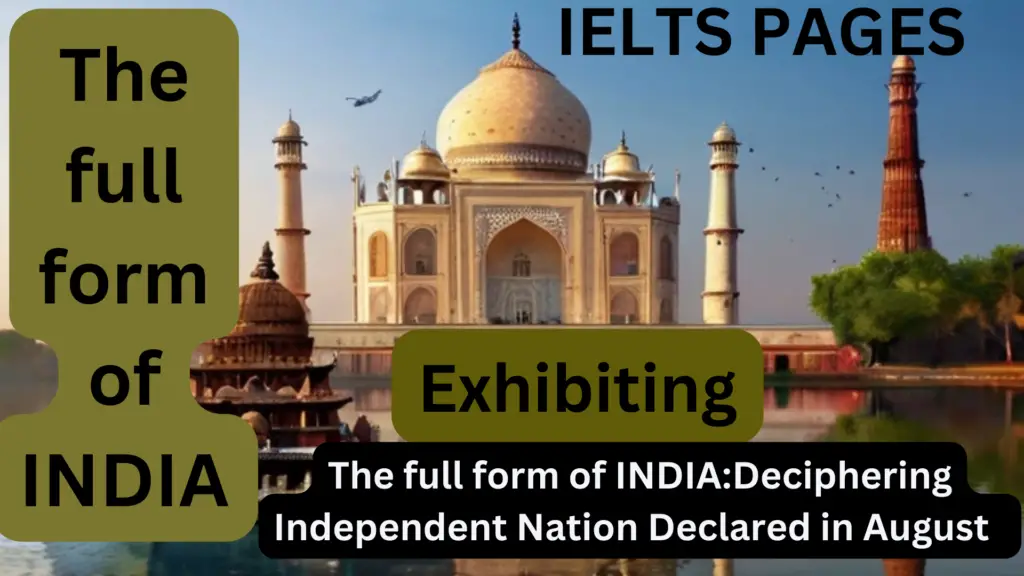
The full form of INDIA
India is a famous country worldwide and is well known for its culture and traditions. And people still need to learn the full form of India. In literal terms, it is known as “an independent nation that was declared in August.” That’s what the general public calls it in this way.
However, the name India only carries part of the form. And we cannot say it is an acronym. The current name has historical significance, which has roots in its geography. And the current name has taken hundreds of years to evolve.
So, regarding the main details about India and its geographical location, India falls in South Asia and is known for its unique identity. Its enormous and diverse landscape includes the Himalayan mountain range on the north side. It also has a massive coastline near the Indian Ocean to the south.
Independence.
Britishers ruled for close to 200 years. Earlier, the East India Company used to rule it. After that, the Queen of England started ruling it. The formal date India gained independence from British colonial rule was August 15, 1947. And this day is known as Independence Day. And there’s a public holiday, which people from all states of India celebrate with pomp and show.
The freedom that India gained on Independence Day took work. And numerous prominent leaders played a pivotal role. The key figures were Mahatma Gandhi, Sardar Vallabhbhai Patel, Jawaharlal Nehru, Bhagat Singh, Chandrashekhar Azad, and many more.
Republic.
After gaining independence, the higher authorities left no stone unturned to frame India’s constitution. And under the aegis of Dr. Bhimrao Ambedkar, a team worked tirelessly. It also formed the constitution, which made inroads on January 26, 1950. And the whole of India celebrates that day as a Republic Day. Because on that day, the Indian Republic was formalized.
Diversity.
One feature which distinguishes India from other nations is its cultural diversity. Diversity is when people speak altogether different languages and practice divergent religions. There are innumerable traditions across cultures, and the cuisine varies every hundred miles.
Talking about religions, people from Hinduism, Islam, Christianity, Buddhism, Jainism, and Sikhism rub shoulders together in various tasks. Most people work in tandem in various government departments and the private sector. This cultural diversity is also visible in the sports team.
States and Union Territories.
There are 28 states in India, and there are 8 Union Territories. And all these establishments have their own government and administration system. The capital of India is named New Delhi, which is in the northern part. It is not a state; it’s a Union Territory.
Economy
Moving further to the economy, India is the world’s fastest-growing economy. The key sectors providing momentum are the IT, farming, manufacturing, and services sectors. Indian IT industry has carved a niche, one of the pillars that has provided the economy with unabated support.
Due to this, there is burgeoning growth, and many other countries are seeking flashes of inspiration from India for their tremendous growth. The country is a member of the G20 group of major economies, which is a wonderful achievement.
Culture
Moving further to India’s culture, there is no doubt that it is rich and diverse. Art, music, dance, and literature have a long history and are available in holy texts like Vedas.
One of the success stories is the Indian movie industry, Bollywood, which has gone global, and its film stars have a global audience.
Languages
India has divergent languages, and hundreds are spoken in different parts of India. As far as official languages at the national level are concerned, those are Hindi and English. Most of the states in India have their official languages. In some cases, in certain states, there is more than one language.
Indian democracy.
There is no denying this conviction that India is the world’s biggest democracy, and the system of governance is parliament-based. Elections happen on a massive scale at national, state, and local levels, and elections are a regular affair.
Challenges and achievements
When discussing India’s challenges and achievements, the biggest challenge is the burgeoning population, leading to numerous problems, such as a large section of society living in impoverished conditions.
Moreover, quality healthcare is only available to a portion of society, and good educational institutions are outside the hinterlands. Due to the need for more skilled people and training, a mass exodus of people from rural to urban areas leads to environmental issues.
The growing population leads to deforestation, so certain species are on the verge of extinction.
However, despite these many problems, the country has progressed tremendously in divergent domains. Its space program is well known and has helped us with missions like Mangalyaan and Chandrayaan.
Moreover, nuclear capability is also high, and the continuous progress in science and technology has made it a strong pillar for handling the world’s pressing problems.
The pharmaceutical sector provides medicines worldwide, and during the coronavirus pandemic, the vaccines developed in India were used worldwide.
Global influence of India.
India’s role is pivotal in international affairs, and various international organizations thrive primarily on it, such as the United Nations, BRICS, and the Commonwealth. Whenever a problem arises in any nation, the Indian government always provides unstinted support.
Conclusion
India is a country with a vast and rich culture. Its holy texts contain tremendous information, which plays a pivotal role in today’s world of science and technology.
India’s significance in science and technology is unmatchable. Its economic growth, cultural heritage, and democratic system make it a wonderful place, and its influence is on a global level.
